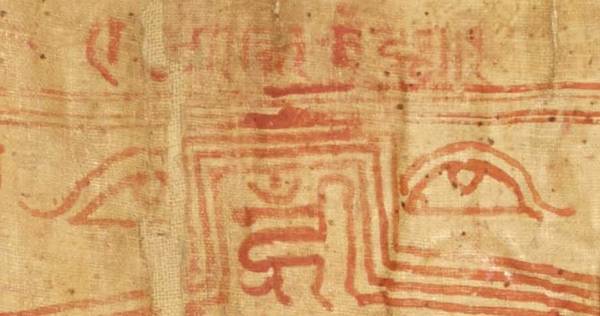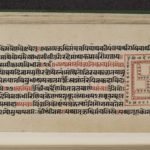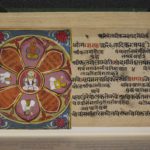Article: Sūri-mantra-paṭa
A sūri-mantra-paṭa is a type of mystical diagram – maṇḍala or yantra – inscribed with formulas of homage and magic syllables – mantras. Most Jain yantras are used in rituals and meditation by both mendicants and lay people, and are important parts of worship. In contrast, only Śvetāmbara monks use sūri-mantra-paṭas and primarily in certain situations.
The sūri-mantra-paṭa is associated with the highest monastic rank of sūri, from which it gets its name. It is particularly linked with Indrabhūti Gautama. As the leading disciple of the 24th Jina, Mahāvīra, he provides a model of spiritual devotion and leadership for the worshipper. Śvetāmbara mendicants use this mystical diagram to mark the elevation of a monk to the level of sūri, a title for the leader of a religious order. According to tradition, the sūri-mantra was also used to perform miracles and win converts.
Sūri-mantra-paṭas take the shape of either circles or squares and consist of sets of mantras and auspicious symbols arranged in patterns on a square cloth. The mantras are phrases or syllables that invoke the powers of the Jinas and other holy figures as well as key Jain concepts or beliefs. These phrases and the auspicious illustrations are believed to aid the worshipper’s prayers and meditations, and bestow good fortune on the devotee.
Sūri-mantra-paṭas are known from the 15th century onwards and are still made today. They are usually kept within the monastic community and are seldom found outside Indian collections, yet one of the highlights of JAINpedia is the sūri-mantra-paṭa held by the Royal Asiatic Society (RAS) in London. Its rarity is also due to its age, because it is one of the earliest known examples. It looks decidedly different in style from those favoured by contemporary Jains. In addition, the RAS paṭa bears two auspicious symbols on its reverse side, which were uncovered during recent conservation work.
Purpose

Siddhacakra
Image by British Library © CC0 1.0 (Creative Commons Public Domain)
A sūri-mantra-paṭa is a special kind of mystical diagram. A mystical diagram is a maṇḍala or yantra and is usually described as a paṭa when it is on cloth. Yantras can be painted on paper or marked out in ink and are of many kinds. At the heart of Jain worship for all sects, different maṇḍalas are used for various purposes.
Only Śvetāmbara monks of the highest monastic rank use the sūri-mantra-paṭa. Like all yantras, it contains mantras and other auspicious words and symbols to perform worship and to help in meditation.
The best-known examples of mantras today are the:
- siddhacakra – in which homage is paid to the Five Supreme Beings and the four virtues, which is also called the navapada
- pañca-namaskāra – which relates to the five homage formula
- stanzas 42 or 46 of the Bhaktāmara-stotra, a favourite Jain hymn – which emphasise how repeating a Jina’s name as a mantra can soothe fear and cure disease.
Using the yantra
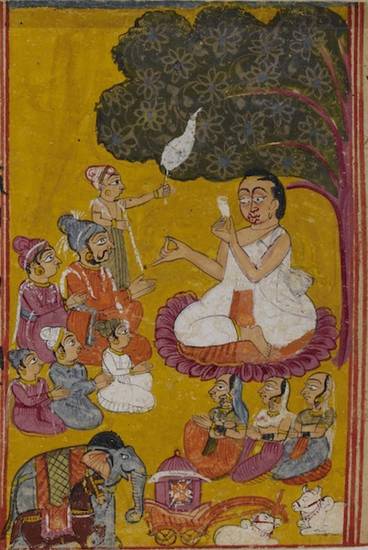
Indrabhūti Gautama preaches
Image by British Library © CC0 1.0 (Creative Commons Public Domain)
Śvetāmbara Mūrti-pūjak monks, especially the Kharatara-gaccha and the Tapā-gaccha, use these sūri-mantra-paṭas for recitation of mantras and for meditation or worship when they are initiated into the higher grades of religious hierarchy. Indeed, this type of yantra takes its name from the term sūri, which is the highest monastic rank, used for the head of a monastic order. Traditional records describe sūris harnessing the power of the maṇḍala to perform miracles to make converts and placate evil deities.
When a monk is considered by his elders to be spiritually eligible to receive the rank of a pontiff, he is given this title in an initiation ceremony performed in the presence of the fourfold community. The guru whispers a mantra in his right ear, signifying that he has now attained the position of a sūri.
The earliest reference to such a ritual is possibly by Haribhadra, in the 8th century. He has ‘a description of how a pupil, on the appropriate day and in a suitable state of purity, should be given the sūrimantra by his teacher along with sprinkling of the head with sandalwood powder (abhivāsanā), the latter being a consistent feature of ascetic ritual’
Dundas 1998: 36
Sometimes, the term ‘sūri-mantra-paṭa’ is improperly used as a generic name when a monk receives a lower title than sūri. In this case the proper mantra is the vardhamāna-vidyā.
More generally, monks who worship a sūri-mantra-paṭa wish to emulate Indrabhūti Gautama or Gautama-svāmin, the foremost disciple of Mahāvīra, who is an emblematic figure of both disciple and teacher (Dundas 1998). According to tradition, the practice is said to have originated at the time of Mahāvīra. He instructed his disciple to compose the mantra, which is regarded as ‘the best of all’ – sarva-śreṣṭha. Hence Gautama is often shown at the centre of the diagram.
The chroniclers of the Kharata-gaccha monastic order have taken particular care to show that monastic teachers could use the sūri-mantra for more than the ritual for teacher consecration. Other uses would be to:
demonstrate his authority within his sect by mastering through meditation and ritual the various magic powers embodied in the mantra, such as curing disease and overcoming enemies, and thus to transform himself into the latter-day equivalent of Gautama, the miracle-working favourite disciple of the twenty-fourth tīrthaṃkara, Mahāvīra
Dundas 2000: 233
These activities were intended to win over ascetics of other creeds or yoginīs who controlled pilgrimage places (Dundas 2000).
Shape and material
A sūri-mantra can be square or round. It can be drawn and painted on paper or on cloth. If it is on cloth, it is called a paṭa.
If the sūri-mantra-paṭa is a circle, it is normally placed within a square. It consists of a varying number of concentric circles and can be of different levels of complexity. Such a diagram can also be viewed as a miniature representation of the Jain universe.
Different sūri-mantra-paṭas are reproduced in Shah 1948 and Jambuvijaya 1977, or in catalogues of Jain art objects. One is exhibited permanently in the L. D. Museum in Ahmedabad. Another one from around 1600 is available at the Virginia Museum of Fine Arts and is described in Pal 1994: 228–229.
Content
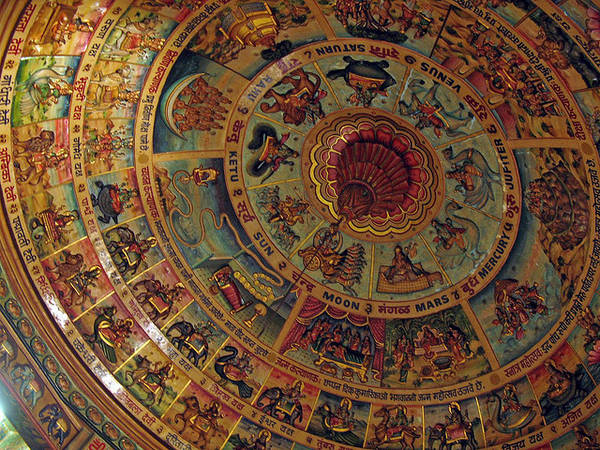
Heavenly entities and gods decorate a temple ceiling
Image by Cactusbones – Sue Ann Harkey © CC Attribution-NonCommercial-ShareAlike 2.0
Maṇḍalas usually contain both pictures and text. The text is usually a set of mantras plus instructions while the illustration consists of auspicious symbols.
The textual parts of this yantra comprise Sanskrit or Prakrit formulas of homage to teachers and deities or concepts such as kinds of knowledge and spiritual attainments. These are arranged in the concentric circles of the maṇḍala, occasionally divided into compartments. The phrases are partly standardised, but they can be arranged in different ways, so that there are hardly any identical sūri-mantra-paṭas. Over the centuries many Jain teachers have commented upon these formulas (Jambuvijaya 1977). They are interspersed with magic syllables such as hrīṃ and śrīṃ.
The devotee invokes all beings, from Jinas to deities, so that they enhance the worship connected with this diagram. This is expressed in the Sanskrit phrase:
pūjāṃ pratīcchantu, svāhā
May such and such deities / demons / teachers …. grace the worship
This phrase recurs in most yantras.
In some portions of the text, there are instructions for using the maṇḍala. There are indications of the number of times a mantra should be recited and what kind of worship or meditation it should be used for.
Yantras always include auspicious symbols. These auspicious symbols may be miniature pictures of Jinas or other holy figures, some of the eight auspicious symbols – aṣṭa-mangala – or pairs of eyes. A pair of eyes is believed to convey auspiciousness, and is thus also found on auspicious jars – mangala-kalaśas. The origin of this auspicious symbol is unknown, however.
Ritual handbooks
It is often considered that only oral transmission could guarantee the preservation of the sūri-mantra, that it was secret and not written down. Yet it has become a special literary genre with ritual handbooks produced in the medieval period, which give various versions. Details of some examples are given in the table and are taken from Dundas 1998: 38 and Jambuvijaya 1977.
|
Title |
English rendering |
Author |
Date |
Mendicant order |
|---|---|---|---|---|
|
Mantra-rāja-rahasya |
Secrecy of the Kings of Mantras |
Siṃhatilaka-sūri |
13th century |
|
|
Sūri-mantra-kalpa |
Ritual of the Sūri-mantra |
Rājaśekhara-sūri |
14th century |
Maladhārīya-gaccha |
|
Sūri-mantra-br̥hat-kalpa-vivaraṇa |
Explanation of the Large Ritual of the Sūri-mantra |
Jinaprabha-sūri |
14th century |
Kharatara-gaccha |
|
Sūri-mukhya-mantra-kalpa |
Ritual of the Main Mantra, the Sūri-mantra |
Merutuṅga-sūri |
14th to 15th centuries |
Añcala-gaccha |
Royal Asiatic Society yantra
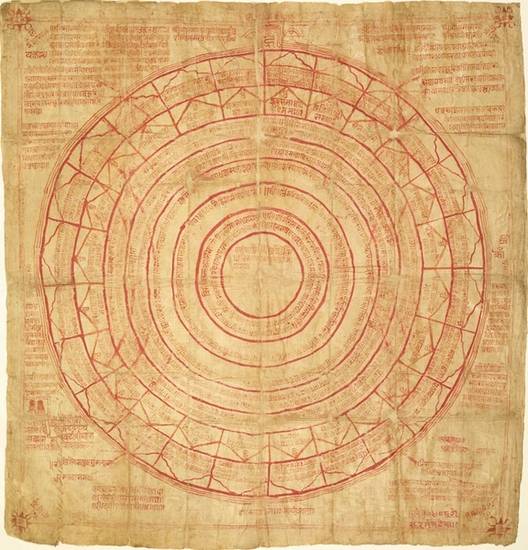
Sūri-mantra-paṭa
Image by Royal Asiatic Society © Royal Asiatic Society Images/RAS, London
Sūri-mantra-paṭas are normally used only by mendicants within their monastic orders. They are rarely found outside the Śvetāmbara monastic community or outside collections in India so the one held by the Royal Asiatic Society (RAS) is very valuable. It is also one of the oldest surviving sūri-mantra-paṭas. Unfortunately, the provenance of this object is not documented even in the institutional archives, but a great deal of information can be gleaned from the paṭa itself.
The RAS example is round and looks quite different from the majority of modern-day sūri-mantra-paṭas because it is chiefly textual. As with all maṇḍalas, it contains numerous mantras intended to invoke:
- all the Jinas
- distinguished Jain teachers
- powerful deities and beings
- sacred concepts.
This sūri-mantra-paṭa is associated with the Kharatara-gaccha sect. This Śvetāmbara monastic order emerged in western India around the 12th century. The maṇḍala dates back to 1449 CE, according to the date written on it, which appears to be genuine. The RAS sūri-mantra-paṭa may never have been used as a tool of worship or meditation, however.
Conservation and restoration work in 2013 uncovered two more yantras on the back of this sūri-mantra-paṭa, which may have been hidden for centuries.
Pattern and illustrations
This round sūri-mantra-paṭa is rather elaborate, with seven circles, not counting the central one. It is similar to number 14 in the standard collection edited by Muni Jambu-vijaya in 1977. At the top, in the centre of the page, is hrīṃ, the magic and sacred syllable, flanked on each side by an eye. The pair of eyes is believed to convey auspiciousness and can be seen on other sacred objects.
Since it is sober and chiefly text, this example contrasts with modern sūri-mantra-paṭas, which are often painted in vivid colours and have little text, such as this one on Flickr and this one on HereNow4U.
Mantras
In the central circle is the main formula, which here pays homage to Gotamasvāmin, referring to Indrabhūti Gautama, the first disciple of Mahāvīra. An image of Gautama is frequently placed in the middle of a sūri-mantra, because he was the 24th Jina’s highest-ranking disciple and the first mendicant in Mahavira‘s monastic lineage. He is the spiritual example whom mendicants seek to imitate.
Moving from the outside in, within the second circle homage is paid in turn to the 24 Jinas, whose names are given in 24 boxes.
The paṭa contains many formulas of homage, such as those to:
- the different types of knowledge the Jains recognise
- the various kinds of monks possessing these types of knowledge
- terms or concepts of the doctrine
- the nine planets – nava-grahas – which often feature in Jain yantras
- the four groups of Jain deities – Bhavanapati, Vyantara, Jyotiṣka, Vaimānika – at several places
- other groups of beings such as the yakṣas and yakṣīs
- the 16 vidyā-devīs – ‘goddesses of knowledge’ – who reign over particular magical knowledge or powers
- various categories of demons, such as preta, piśāca, rākṣasa, śākinī, ḍākinī and yākinī.
Occasionally, there are scattered Sanskrit stanzas where homage to these deities is offered. For instance, there is a verse dedicated to Śrī-devī in the left side of the bottom part of the yantra. On the right side, in the middle part, there is a stanza in Prakrit offering homage to the 23rd Jina, Pārśvanātha or Lord Pārśva.
Monastic order
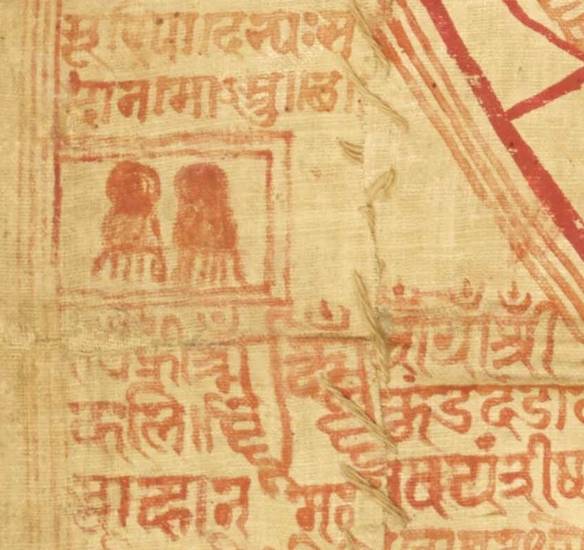
Footprints of Jinacandra-sūri
Image by Royal Asiatic Society © Royal Asiatic Society Images/RAS, London
It is clear that this sūri-mantra-paṭa is connected to the Śvetāmbara monastic order known as the Kharatara-gaccha, which has been present in Western India, especially Rajasthan, since the 11th century. Indeed, the sūri-mantra ‘clearly played a significant part in establishing sectarian identity for the followers of an ascetic group like the reforming Kharatara Gaccha’ (Dundas 1998: 36) and in the legitimation of their leaders.
Paradoxically, the name of the order itself does not appear. Instead, the phrase ‘our gaccha’ – asmad-gaccha – is given at several places. In the top-left corner there is a list of names of the successive heads of the Kharatara-gaccha order, so the identity of the order as the Kharatara-gaccha is clear. The list of sūris is given as:
- Vardhamāna-sūri
- Jineśvara-sūri
- Jinacandra-sūri
- Abhayadeva-sūri
- Jinavallabha-sūri
- Jinadatta-sūri.
Vardhamāna-sūri (died 1031 CE) was the founding teacher of this monastic order in the 11th century. The deity Dharaṇendra is thought to have revealed the meaning and secret of the sūri-mantra to him, and thereafter this monastic order has considered the yantra a magic spell. Jineśvara-sūri is the monk who consolidated the order. Then come his disciples and successors.
The monastic lineage is continued in the top-right part of the maṇḍala as:
- Jinacandra-sūri
- Jinapati-sūri (1153–1222 CE).
These are two teachers who succeeded each other as monastic leaders in the 12th century. Thus they are not contemporary with the diagram, but illustrious predecessors who are offered homage. Jinapati-sūri is one of those who could win over yoginīs through the use of the sūri-mantra (Dundas 2000).
The name of Jinacandra-sūri appears also on the lower part of the left side of the diagram, above the footprints – pādukās. This text pays homage to him:
śrīJinacandrasūri-pādebhyaḥ sadā namo ‘stu //
May there always be homage to the feet of Jinacandra-sūri
Several heads of the Kharatara-gaccha had the name Jinacandra-sūri and lived in very different times. The footprints are usually commemorative, so it indicates that the Jinacandra-sūri referred to was not alive when the yantra was made. It is likely that the footprints and homage refer to the one listed in the top right, who is one of the Dādā-gurus. These are the major teachers of this monastic order, who largely owe their fame to their miraculous powers (see Babb 1996).
Date
The RAS document has a date in the middle of the right-hand portion:
saṃvat 1506 pratiṣṭito ‘[yam] ārādhaka
it was consecrated in the year 1506 of the Vikrama era. The worshipper is this
This date corresponds to 1449 CE. If this date is authentic and genuinely refers to the year when the object was consecrated, it means it is an old specimen and thus very valuable.
During the period corresponding to this date, the head of the Kharatara-gaccha was Jinabhadra-sūri, but his name does not appear anywhere here. However, there is no clear reason to doubt the authenticity of the date on the yantra.
One element of information is missing, however. This is the name of the ārādhaka, namely the monk who would have worshipped this diagram and become a sūri using this diagram. This indicates that this yantra was perhaps not actually used.
Modern label
Here, the object designation appears in the last line of the bottom right corner. Written by a hand different from all the rest, this label states:
//saṃvat 406 ro Sūramaṃtra ṭebā //1//
commentary on the sūrimantra of saṃvat 406
The term ṭebā is a variant of ṭabo, which is a Gujarati word meaning ‘commentary’ or ‘word-to-word paraphrase’. The term ro is the Rajasthani postposition meaning ‘of’.
The date as written here is strange. But the intention of the writer is certainly to identify the maṇḍala with a tag and a repetition of the original date of 1506, before selling or presenting it as a gift. This label thus is likely to date back to the 19th century, when many Jain manuscripts and yantras changed hands, and was added to the object for identification.
Reverse side
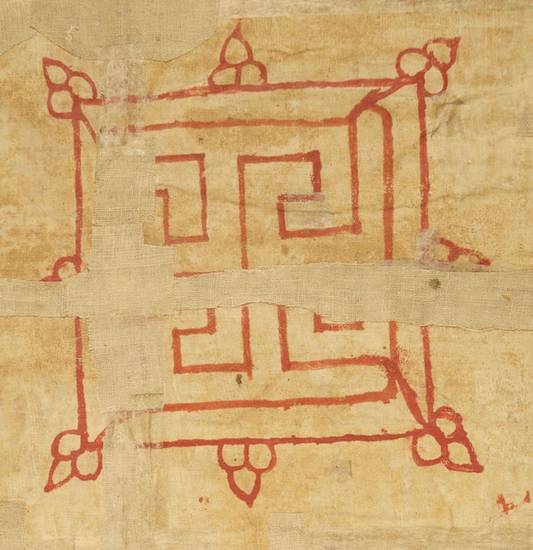
Nandyāvarta
Image by Royal Asiatic Society © Royal Asiatic Society Images/RAS, London
Unusually, this paṭa has more mystical diagrams on its back. At first sight, the reverse of the cloth was blank. But the restoration and conservation work to prepare the sūri-mantra-paṭa for digitisation on JAINpedia led to the discovery of an intermediate lining somehow fixed at the back of the recto.
In this lining two labyrinth-shaped diagrams in red are visible. But they are not inscribed with mantras. The two symbols are examples of the nandyāvarta, which is one of the eight auspicious symbols – aṣṭa-mangala. It is unknown when these diagrams were inked onto the reverse of the main maṇḍala, but it is probable that adding them was thought to increase the auspicious power of the yantra.
Reading
- Absent Lord: Ascetics and Kings in a Jain Ritual Culture
Lawrence A. Babb - Comparative Studies in Religion & Society series; volume 8
University of California Press; Berkeley, California, USA; 1996
- ‘Becoming Gautama: Mantra and History in Śvetāmbara Jainism’
Paul Dundas - Open Boundaries: Jain Communities and Cultures in Indian History
edited by John E. Cort
SUNY Series in Hindu Studies series
State University of New York Press; Albany, New York, USA; 1998
- ‘The Jain Monk Jinapati Sūri Gets the Better of a Nāth Yogī'
Paul Dundas - Tantra in Practice
edited by David Gordon White
Princeton Readings in Religions series; series editor Donald S. Lopez Jr; volume 8
Princeton University Press; Princeton, New Jersey, USA and Oxford, UK; 2000
- Comparative and Critical Study of Mantrashastra (With Special Treatment of Jain Mantravada): Being The Introduction to Sri Bhairava Padmavati Kalpa
Mohanlal Bhagwandas Jhavery - Sri jain kala sahitya samsodhak (Jain Art Publication) series; volume 1
Sarabhai Manilal Nawab; Ahmedabad, Gujarat, India; 1944
- 'Kharataragacchagurvāvalī'
ŚrīJinapālopādhyāyādi-saṅkalita - Kharataragacchabṛhadgurvāvali
edited by Muni Jambuvijaya
Singhi Jain series; volume 42
Bhāratīya Vidyā Bhavana; Bombay, India; 1956
- Śrī Sūrimantra Kalpa Saṃdoha: Pandar Pariśiṣṭo tathā Gujarātī Bhāṣāntara Sahit (Sacitra)
Pandit Ambalal Premacand Shah - Sarabhai Manilal Nawab; Ahmedabad, Gujarat, India; 1948
- Kharataragaccha kā Bṛhad Itihāsa
Mahopādhyāya Vinayasāgar - edited by Sāhitya Vācaspati
Prākṛta Bhāratī Puṣpa series; volume 161
Prakrit Bharati Academy; Jaipur, Rajasthan, India; 2005
- Kharataragaccha pratiṣṭhā lekha saṃgraha (12vīṃ śatī se lekar 20vīṃ śatī tak kharataragacchācāryoṃ dvārā pratiṣṭhita pratimā lekhoṃ kā saṃgraha)
Mahopādhyāya Vinayasāgar - Prākṛta Bhāratī Puṣpa series; volume 182
Prakrit Bharati Academy; Jaipur, Rajasthan, India; 2005
Links
- Sūri-mantra-paṭa
-
The Virginia Museum of Fine Arts presents this colourful sūri-mantra-paṭa dating to the second half of the 17th century. Click on the picture to view the image in more detail.
Sūri-mantra-paṭas are yantras used only by Śvetāmbara Mūrti-pūjak monks, especially the Kharatara-gaccha and the Tapā-gaccha, when they reach the rank of sūri. Typically, this example depicts Indrabhūti Gautama, the first disciple of Mahāvīra, in the centre.
- King of mantras
-
An image of a contemporary Br̥had Sūrimantra Paṭa on Flickr. This maṇḍala is used in rituals of worship, specifically by the highest-ranking monks in the various Śvetāmbara Mūrti-pūjak orders. This example is mainly made up of colourful illustrations, with auspicious symbols, mantras and figures surrounding Indrabhūti Gautama, in the centre. As the lead disciple of Mahāvīra, Gautama is the role model of the perfect ascetic leader.
- Gold sūri-mantra-paṭa
-
This striking gold-and-black sūri-mantra-paṭa presents Indrabhūti Gautama in the middle. He sits within two triangles positioned within concentric circles, surrounded by holy figures and scenes of worship. Gautauma was the head disciple of the 24th Jina, Mahāvīra, and his spirituality and leadership provide an example to which monks aspire. Such yantras are used by leaders of Śvetāmbara Mūrti-pūjak mendicant orders, with the Kharatara-gaccha in particular ascribing great powers to these ritual objects.
http://media-cache-ak0.pinimg.com/736x/f7/71/16/f77116fcefae48ee6c309862fc18a736.jpg
- Contemporary sūri-mantra-paṭa
-
An ornate sūri-mantra-paṭa on the Flickr website. A large golden figure of Indrabhūti Gautama, head disciple of Mahāvīra, takes the lotus position in the centre, flanked by worshippers. Rows of deities and worshippers honour him while sacred syllables and the 24 Jinas form rings around him.
This sacred object is used for ritual and meditation by Śvetāmbara Mūrti-pūjak monks, primarily those from the Kharatara-gaccha and Tapā-gaccha. Only top-ranking monks can use it, aiming to imitate Gautama and to harness the power of the maṇḍala.
- Modern sūri-mantra-paṭa
-
A circular sūri-mantra-paṭa on the HereNow4U website. This modern paṭa on a tomato-red background has at its centre an image of Indrabhūti Gautama, head disciple of Mahāvīra, who is being worshipped by lay men. The 24 Jinas and other holy figures sit in concentric circles, separated by a ring of mantras. A pair of auspicious eyes, the hrīṃ mantra and the sun and moon sit above the paṭa.
- +
- aAbhavya
- aAbhinandana
- aAbhiṣeka
- aĀcāra
- aĀcārāṅga-sūtra
- aĀcārya
- aAchalbhrata
- aAḍhāī-dvīpa
- aAdharma
- aAdho-loka
- aAdhyayana
- aAdvaita Vedānta
- aĀgama
- aAghātīya
- aAghātīya-karman
- aAgnibhuti
- aAgra
- aĀhāra
- aAhiṃsā
- aAhimsa Day
- aAjita
- aAjīva
- aAkampit
- aĀkāśa
- aAkbar the Great
- aAkṣaya-tṛtīyā
- aAlauddin Khalji
- aAlbert Einstein
- aAllah
- aAlms
- aĀlocanā
- aAloka-ākāśa
- aAmāri
- aAmbikā or Kūṣmāṇḍinī
- aAnagāra
- aAnanta
- aAnarthadaṇḍa
- aAnaśana
- aAnekānta-vāda
- aAṅga
- aAniconism
- aAnojjā
- aAntarāla
- aAntarāya-karma
- aAṇu
- aAṇu-vrata
- aAnukampā
- aAnuprekṣā
- aAnusvāra
- aApabhraṃśa
- aAparigraha
- aAra
- aĀrambha
- aĀrambhaja
- aĀratī
- aArdhamāgadhī Prākrit
- aArhaṃ
- aArhat
- aArśana-āvaraṇīya-karma
- aĀrta-dhyāna
- aĀryikā
- aĀryikā Jñānamati
- aĀśātanā
- aĀścarya
- aAscetic
- aAsceticism
- aAshram
- aAspiration
- aĀsrava
- aAṣṭa-maṅgala
- aAṣṭāpada
- aAstikāya
- aAstrolabe
- aAsura
- aAtheism
- aAticāra
- aAtiśayakṣetra
- aAtithisaṃvibhāgavrata
- aĀtma-vāda
- aĀtman
- aAuṃ
- aAurangzeb
- aAuspicious
- aAusterity
- aAvadhāna
- aAvadhi-jñāna
- aĀvaraṇī-yakarman
- aAvasarpiṇī
- aAvatāra
- aAvidyā
- aAxiom
- aĀyāga-paṭa
- aĀyambil
- aĀyu-karma
- aĀyurveda
- bBabur
- bBāhubali
- bBaladeva
- bBālāvabodha
- bBandha
- bBasadi
- bBazaar
- bBhadrankarvijay
- bBhagavant
- bBhaktāmara-stotra
- bBhakti
- bBhale
- bBharata
- bBhāṣā
- bBhāṣya
- bBhaṭṭāraka
- bBhāva
- bBhāva-pūjā
- bBhāvanā
- bBhavana-vāsin
- bBhavya
- bBhavyatva
- bBhaya
- bBhoga-bhūmi
- bBhogopabhoga
- bBodhi
- bBollywood
- bBrahmā
- bBrahma-deva
- bBrahmacārī
- bBrāhmaṇa
- bBraj Bhāṣā
- bBright fortnight
- bBritish Raj
- bBuddha
- bBuddhi-sagar
- bBuddhism
- bBuddhist
- cCaitya
- cCaityavāsin
- cCakravartin
- cCakreśvarī
- cCāmara
- cCandanā
- cCandragupta
- cCandraprabha
- cCanon
- cCāritra
- cCāritramohanīya-karman
- cCarũrī
- cCaste
- cCaturvidha-saṅgha
- cCaturviṃśati-stava
- cCāturyāma
- cCE
- cCelibacy
- cCha
- cChadmastha
- cChastity
- cCheda-sūtra
- cChristian
- cChristianity
- cClergy
- cCloning
- cColophon
- cCommentary
- cConch
- cConfession
- cCongregation
- cConsecration
- cCosmology
- cCremation
- cCrore
- cCult
- cCūrṇi
- dDādā-guru
- dDalit
- dDāna
- dDaṇḍa
- dDark fortnight
- dDarśana
- dDarśanamohanī-yakarman
- dDaśa-lakṣaṇa-parvan
- dDeity
- dDelhi Sultanate
- dDerāsar
- dDeśāvakāśika-vrata
- dDetachment
- dDevanāgarī
- dDevānandā
- dDevarddhi-gani
- dDevotee
- dDhamal
- dDhanuṣ
- dDhāra
- dDharma
- dDharma-dhyāna
- dDharma-sāgara
- dDharmastikaya
- dDhātakīkhaṇḍa
- dDholak
- dDhyāna
- dDiaspora
- dDig-vrata
- dDigambara
- dDīkṣā
- dDisciple
- dDīvālī
- dDivya-dhvani
- dDNA
- dDoctrine
- dDogma
- dDonor
- dDoṣa
- dDravya
- dDravya-pūjā
- dDrone
- dDuṣamā
- dDuṣamā-duṣamā
- dDuṣamā-suṣamā
- dDveṣa
- dDvīpa
- eEast India Company
- eEightfold Path
- eEkānta-vāda
- eEkendriya
- eElder
- eElders
- eEschatology
- eEtc up to
- fFarmān
- fFast
- fFatehpur Sikri
- fFestival
- fFestschrift
- fFiruz Shah
- fFly-Whisks
- fFolio
- fFour Noble Truths
- gGaccha
- gGaṇa
- gGaṇadhara
- gGanadharavada
- gGaṇeśa
- gGaṇin
- gGarba
- gGarbha
- gGarbha-gṛha
- gGaruḍa
- gGati
- gGene
- gGenomics
- gGhātī-yakarman
- gGhātīya
- gGhaznavid
- gGhiyasuddin Tughlaq
- gGhurid
- gGloss
- gGotra-karma
- gGujarāt
- gGujarati
- gGuṇa
- gGuṇa-sthāna
- gGuṇa-vrata
- gGupti
- gGuru
- gGuruṇī
- hHagiography
- hHajj
- hHaṃsa
- hHaribhadra
- hHariṇaigameṣin
- hHasta
- hHeresy
- hHiṃsā
- hHindi
- hHindu
- hHinduism
- hHīravijaya
- hHoroscope
- hHrīṃ
- hHumayun
- hHymn
- iIconoclasm
- iIconography
- iIdol
- iIndian Independence
- iIndology
- iIndra
- iIndrabhūti Gautama
- iIndriya
- iInitiation
- iIntercession
- iInvocation
- iIQ
- iIslam
- iIslamicate
- iIṣṭadevatā
- iĪśvara
- jJagat
- jJahangir
- jJain
- jJaina Devanāgarī
- jJaina Śaurasenī
- jJaina-dharma
- jJainaśāsana
- jJainness
- jJaisalmer
- jJamāli
- jJambū-dvīpa
- jJames Burgess
- jJanma
- jJanma-kalyāṇa
- jJarā
- jJāti
- jJina
- jJina-āgama
- jJina-bhavana
- jJina-bimba
- jJina-mātā
- jJinacandra-sūri
- jJinadatta
- jJinaprabha
- jJīva
- jJñāna
- jJñāna-āvaraṇīya-karma
- jJñāna-āvarṇiya
- jJñānsundar
- jJyotiṣka
- kKāla
- kKālakācārya-kathā
- kKālidāsa
- kKalpa-sūtra
- kKalpa-vṛkṣa
- kKalyāṇaka
- kKalyanvijay
- kKamaṇḍalu
- kKamaṭha
- kKarma
- kKarma-bhūmi
- kKarma-grantha
- kKarma-prakṛti
- kKarma-vāda
- kKarmon
- kKarnataka
- kKaṣāya
- kKathā
- kKāvya
- kKāya
- kKāyotsarga
- kKeśa-loca
- kKetu
- kKevala-jñāna
- kKevalin
- kKhalji
- kKharatara-gaccha
- kKnowledge
- kKriyā
- kKriyā-vāda
- kKṛṣṇa
- kKṣamā-śramaṇa
- kKṣapakaśreṇi
- kKṣatriya
- kKṣullaka
- kKulakara
- kKundakunda
- kKunthu
- lLabdhi
- lLaity
- lLakh
- lLāñchana
- lLands of Action
- lLaukāntika
- lLavaṇa-samudra
- lLeśyā
- lLiṅga
- lLinguistics
- lLoka
- lLoka-ākāśa
- lLoka-puruṣa
- lLoka-vāda
- lLotus
- lLotus lake
- mMadhya-loka
- mMahā-videha
- mMahā-vrata
- mMahābhārata
- mMahāmastakābhiṣeka
- mMāhārāṣṭra
- mMāhārāṣṭrī Prākrit
- mMahattarā Yākinī
- mMahāvīr Jayantī
- mMahāvīra
- mMakāra
- mMakkhali Gośāla
- mMalli
- mMāna-stambha
- mManaḥ-paryāya-jñāna
- mMaṇḍala
- mMaṇḍapa
- mMandit
- mMaṅgala
- mMantra
- mMantras
- mManuṣya-loka
- mMarāṭhī
- mMārgaṇā
- mMartyr
- mMarudevī
- mMaṭha
- mMati-jñāna
- mMauryaputra
- mMecca
- mMendicant lineage
- mMetarya
- mMiracle
- mMithyādṛṣṭi
- mMohandas Gandhi
- mMohanīya-karma
- mMokṣa
- mMonastic order
- mMonasticism
- mMonk
- mMonotheism
- mMosque
- mMount Meru
- mMount Sammeta
- mMṛgāvatī
- mMughal
- mMuhammad
- mMuhammad bin Tughlaq
- mMuhpattī
- mMūla-sūtra
- mMūlaguṇa
- mMumbaī
- mMuni
- mMunisuvrata
- mMurad Bakhsh
- mMūrti-pūjaka
- mMuslim
- mMysticism
- nNābhi
- nNāga-kal
- nNāgapurīya Tapā-gaccha
- nNāgarī
- nNāma-karma
- nNamaskāra-mantra
- nNami
- nNandīśvara-dvīpa
- nNandivardhana
- nNandyāvarta
- nNāraka
- nNāraki
- nNasalisation
- nNātha
- nNavrātrī
- nNaya-vāda
- nNemi
- nNidāna
- nniggaṃthāṇa vā 2
- nniggaṃtho vā 2
- nNigoda
- nNihnava
- nNikṣepa
- nNirgrantha
- nNirjarā
- nNirvāṇa
- nNiryukti
- nNiṣidhi
- nNitya
- nNiyati
- nNo-kaṣāya
- nNudity
- nNun
- oOcean of milk
- oOmniscience
- oOrdination
- ppa°
- pPadmaprabha
- pPadmāsana
- pPadmāvatī
- pPādukā
- pPalanquin
- pPalette
- pPañca-muṣṭi
- pPāṇḍava
- pPaṇḍit
- pPandit Dalsukh D. Malvania
- pPandit Sukhlalji
- pPāṇipātra
- pPāpa
- pParamātman
- pParameṣṭhin
- pPāraṇā
- pParigraha
- pPariṇāma
- pParīṣaha
- pParokṣa
- pPārśva
- pPārśvanātha
- pParyāya
- pParyuṣaṇ
- pPaṭa
- pPatan
- pPātra
- pPenance
- pPersian
- pPhala
- pPhilology
- pPicchikā
- pPilgrimage
- pPīr
- pPolymath
- pPoṣadha
- pPossession
- pPothī
- pPrabhas
- pPradakṣiṇā
- pPradeśa
- pPrākāra
- pPrakīrṇaka-sūtra
- pPrākrit
- pPramāda
- pPramukhā
- pPrati-vāsudeva
- pPratikramaṇa
- pPratimā
- pPratiṣṭhā
- pPratyākhyāna
- pPratyakṣa
- pPravacana
- pPrāyaścitta
- pPrayer
- pPre-modern
- pPreach
- pPredestination
- pProtestant
- pProvenance
- pPudgala
- pPūjā
- pPujārī
- pPukharavara-dvīpa
- pPuṇya
- pPūrva
- pPuṣkara-dvīpa
- pPuṣpadanta
- pPyre
- qQur’an
- rRāga
- rRāhu
- rRainy season
- rRajasthan
- rRajasthani
- rRājimatī
- rRajoharaṇa
- rRajput
- rRāma
- rRāmāyaṇa
- rRangoli
- rRās-garbā
- rRasa
- rRathanemi
- rRatna-traya
- rRātri-bhojana
- rRaudra-dhyāna
- rRecto
- rRelic
- rRenunciation
- rRetroflex
- rRevatī
- %Ṛg-veda
- rRite
- rRosary
- %Ṛṣabha
- %Ṛṣabhanātha
- rRupee
- sSaciyā Mātā
- sSādhu
- sSādhvī
- sSāgāra
- sSaint
- sŚaivaism
- sŚaka-saṃvat
- sSallekhanā
- sŚalya
- sSamacatuṣṭha
- sSamādhimaraṇa
- sSamaṇi
- sSāmarambha
- sSamavasaraṇa
- sSāmāyika
- sSaṃbhava
- sSamiti
- sSaṃjñā
- sSaṃkalpaja
- sSaṃsāra
- sSamudghāta
- sSaṃvara
- sSaṃvega
- sSamyak-cāritra
- sSamyak-darśana
- sSamyak-jñāna
- sSamyaktva
- sSaṃyama
- sSanctuary
- sSandalwood
- sSaṇgha
- sSanskrit
- sSant
- sŚānti
- sSapta-bhaṅgi-naya
- sSārambha
- sSarasvatī
- sSarvajña
- sSāsan-devi
- sŚāsana-devatā
- sŚāstra
- %Ṣaṭ-jīvanikāya
- sSatī
- sSatīmātā
- sSatya
- sSchism
- sScribe
- sScripture
- sSect
- sSecularism
- sŚenāī
- sSermon
- sŚeṣavatī
- sSevā
- sSeven fields of donation
- sShah Jahan
- sShantidas Jhaveri
- sShrine
- sSiddha
- sSiddha-śilā
- sSiddhacakra or Navadevatā
- sSiddhānta
- sSiddhārtha
- sSiddhi
- sSikh
- sSikhism
- sŚikṣā-vrata
- sŚīla
- sSin
- sSindh
- sŚītala
- sŚiva
- sSkandha
- sSomanatha
- sŚraddhā
- sŚramaṇa
- sŚrāvaka
- sŚrāvakācāra
- sŚrāvikā
- sŚreyāṃsa
- sŚrī
- sŚrīvatsa
- sŚruta-jñāna
- sŚruta-pañcamī
- sSthānaka-vāsin
- sSthāpanācārya
- sSthāvara
- sSthavira
- sSthiti
- sStrīmukti
- sStūpa
- sSubcontinent
- sSudarshana
- sŚuddhi
- sSudharma
- sŚūdra
- sSufism
- sSukha
- sŚukla-dhyāna
- sSulasā
- sSultan
- sSumati
- sSundarśrī
- sSupārśva
- sSūri
- sSuṣamā
- sSuṣamā-duṣamā
- sSuṣamā-suṣamā
- sSūtra
- sSuyam me ausam! Tenam bhagavaya evamakkhayam
- sSvādhyāya
- sSvāhā
- sSvastika
- sŚvetāmbara
- sŚvetāmbara Terāpanthin
- sŚvetāmbaras
- sSwan
- sSyād-vāda
- tTabla
- tTantra
- tTapā-gaccha
- tTapas
- tTāraṇ Svāmī Panth
- tTattva
- tTattvārtha-sūtra
- tTemple
- tTemple-city
- tThe Enlightenment
- tTheology
- tThree worlds
- %Ṭīkā
- tTilaka
- tTīrtha
- tTīrthaṃkaranāma-karman
- tTīrthankara
- tTransliteration
- tTrasa
- tTrasa-nāḍī
- tTriśalā
- tTriṣaṣṭi-śalākā-puruṣa-caritra
- tTti bemi
- tTughlaq
- tTunk
- uUdumbara
- uUniversal History
- uUpādhyāya
- uUpāṅga
- uUpaniṣads
- uUpāsaka
- uUpasarga
- uUpāśraya
- uŪrdhva-loka
- uUtsarpiṇī
- uUttarādhyayana-sūtra
- vVāhana
- vVaimānika
- vVairāgya
- vVaiṣṇava
- vVaiśramaṇa
- vVaiśya
- vValabhī
- vVanaspatikāya
- vVandana
- vVaṇik
- vVarṇa
- vVāsudeva
- vVāsupūjya
- vVayubhūti
- vVeda
- vVedanīya-karma
- vVegetarianism
- vVehicle
- vVernacular
- vVerso
- vVidyā
- vVidyā-devī
- vVihāra
- vVijñapti-patra
- vVikrama-saṃvat
- vVikṛti
- vVimala
- vVinaya
- vVipāka
- vVirji Vora
- vVirodhaja
- vVīrya
- vVisarga
- vViṣṇu
- vVītarāga
- vVizier
- vVotive
- vVow
- vVrata
- vVS
- vVyakta
- vVyantara
- vVyasana
- yYakṣa
- yYakṣī
- yYantra
- yYaśoda
- yYaśovijaya
- yYati
- yYātrā
- yYoga
- yYoginī
- yYojana


